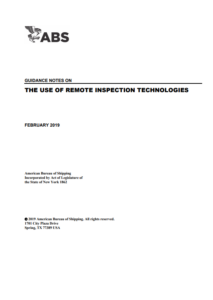ABS published guidance notes on the use of remote inspection technologies, detailing best practices for their use on class surveys and non-class inspections. The guidance notes cover pilot-operated unmanned aerial vehicles, remotely operated underwater vehicles and robotic crawlers, collectively known as remote inspection technologies (RITS).
The use of RITs can reduce risk for Surveyors and inspectors by lessening the need to access potentially hazardous locations at height, or other hazardous inspection areas. This guidance facilitates safer, more effective and efficient, use of these technologies,
…said John McDonald ABS Senior Vice President, Western Hemisphere Operations.
Remote Inspection Vehicle (RIV) Operational Considerations
-In-operation
The remote inspection Service Provider should possess an organizational Standard Operation Procedure (SOP) for each RIV operation. The following action items are recommended to be included in the SOP, at a minimum:
i) Checklist Clearance: The checklist should contain relevant system checks, inspection condition checks, personnel readiness checks, communication equipment checks, and testing RIV operation checks (e.g., flight for UAV, magnetic capability for crawler, underwater operation for ROV).
ii) RIV Launch and Recovery Zones: For typical restrictions of launch and recovery zones to be considered, see Section 4, Table 3, below:
- UAVS: Launch and recovery zones should be identified, and access should be restricted. It is recommended that the designated landing zone(s) remain clear of any personnel and obstacles during the inspection process in case of any unexpected lost-link incidents.
- ROVs: Launch and recovery zones should be identified, and access should be restricted. It is recommended that the designated launch and recovery zones remain clear of any personnel during the inspection process to avoid tripping hazards of tethers.
- Robotic Crawlers: Launch and recovery zones should be identified, and access should be restricted. It is recommended that the designated launch and recovery zones remain clear of any personnel during the inspection process in case of any unexpected dropped crawlers and modules
iii) Communication: If the communication signal is lost or experiences significant interference, the operation should be aborted immediately. The time and duration of each lost-link event should be recorded by the RIV operations team and reported through the incident reporting system in Safety Assurance.
iv) Documentation: Whenever conditions that do or may affect Classare found during operations, reference data (i.e., still image capture, location and orientation in relation the vessel, etc.) should be properly documented for final reporting and be documented in the operations and maintenance logbooks.
v) Visual Line of Sight (VLOS) for UAVs: Some aviation authorities require human direct and unaided VLOS be maintained throughout the operation. It is recommended that VLOS be maintained even if no regulatory requirement applies. Extended VLOS (EVLOS) or beyond VLOS (BVLOS) can be accepted upon agreement by all parties when no regulatory requirements apply.
vi) De-confliction for UAV: Procedures should be in place so that adequate de-confliction with helicopters or surface vessels servicing the asset is achieved (e.g., There should be no UAV operations for external inspection within 30 minutes prior to scheduled helicopter activities). The attending Surveyor should be present and direct the RIV operations team, as needed, with regard to the survey requirements
Explore more herebelow:































































